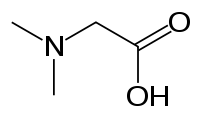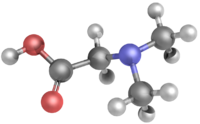- Dimethylglycine
-
N,N-Dimethylglycine 
 N,N-DimethylglycineOther names2-(dimethylamino)acetic acid
N,N-DimethylglycineOther names2-(dimethylamino)acetic acidIdentifiers CAS number 1118-68-9 
PubChem 673 ChemSpider 653 
EC-number 214-267-8 DrugBank DB02083 KEGG C01026 
MeSH Dimethylglycine ChEBI CHEBI:58251 
Jmol-3D images Image 1 - O=C(O)CN(C)C
Properties Molecular formula C4H9NO2 Molar mass 103.12 g/mol  (verify) (what is:
(verify) (what is:  /
/ ?)
?)
Except where noted otherwise, data are given for materials in their standard state (at 25 °C, 100 kPa)Infobox references Dimethylglycine (DMG) is a derivative of the amino acid glycine with the structural formula (CH3)2NCH2COOH. It can be found in beans and liver. It can be formed from trimethylglycine upon the loss of one of its methyl groups. It is also a byproduct of the metabolism of choline.
When DMG was first discovered, it was referred to as vitamin B16, but, unlike true B vitamins, deficiency of DMG in the diet does not lead to any ill-effects meaning it does not meet the definition of a vitamin. In legal terms, it has been deemed a food product and, as such, is available without a practitioner or prescription.
Uses
Dimethylglycine has been suggested for use as an athletic performance enhancer, immunostimulant, and a treatment for autism, epilepsy, or mitochondrial disease.[1][2] Published studies on the subject have shown little to no difference between DMG treatment and placebo.[3][4]
References
- ^ "Dimethylglycine". About Herbs, Botanicals & Other Products. Memorial Sloan–Kettering Cancer Center. December 8, 2009. http://www.mskcc.org/mskcc/html/69204.cfm.
- ^ Chinnery P, Majamaa K, Turnbull D, Thorburn D (2006). "Treatment for mitochondrial disorders". Cochrane Database of Systematic Reviews (Online) (1): CD004426. doi:10.1002/14651858.CD004426.pub2. PMID 16437486.
- ^ Bolman WM, Richmond JA (June 1999). "A double-blind, placebo-controlled, crossover pilot trial of low-dose dimethylglycine in patients with autistic disorder". Journal of Autism and Developmental Disorders 29 (3): 191–4. PMID 10425581.
- ^ Kern JK, Miller VS, Cauller PL, Kendall PR, Mehta PJ, Dodd M (March 2001). "Effectiveness of N,N-dimethylglycine in autism and pervasive developmental disorder". Journal of Child Neurology 16 (3): 169–73. PMID 11305684. http://jcn.sagepub.com/cgi/pmidlookup?view=long&pmid=11305684.
Neurotransmitters Amino acids Alanine · Aspartate · Cycloserine · DMG · GABA · Glutamate · Glycine · Hypotaurine · Kynurenic acid (Transtorine) · NAAG (Spaglumic acid) · NMG (Sarcosine) · Serine · Taurine · TMG (Betaine)
Endocannabinoids 2-AG · 2-AGE (Noladin ether) · AEA (Anandamide) · NADA · OAE (Virodhamine) · Oleamide · PEA (Palmitoylethanolamide) · RVD-Hpα · Hp (Hemopressin)
Gasotransmitters Monoamines Purines Trace amines 3-ITA · 5-MeO-DMT · Bufotenin · DMT · NMT · Octopamine · Phenethylamine · Synephrine · Thyronamine · Tryptamine · Tyramine
Others 1,4-BD · Acetylcholine · GBL · GHB · Histamine
See also Template:NeuropeptidesGlycinergics Receptor
ligandsAgonistsAlanine • Cycloserine • Dimethylglycine • Glycine • Hypotaurine • Methylglycine (Sarcosine) • Milacemide • Serine • Taurine • Trimethylglycine (Betaine)Reuptake
inhibitorsPlasmalemmalGlyT1 inhibitorsGlyT2 inhibitorsVIAAT InhibitorsEnzyme
inhibitorsSHMT InhibitorsGDC InhibitorsDAAO InhibitorsOthers Categories:- Amino acids
- Dietary supplements
- Biochemistry stubs
Wikimedia Foundation. 2010.
